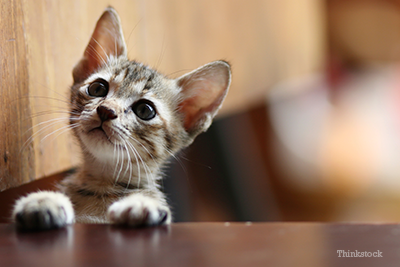When you watch your new kitten play, it seems like no stimulation is needed at all. All the running, jumping, climbing and chasing are enough to tire us out—just by watching. But most of the behaviors we enjoy watching are really evolutionary in their development. If you could watch a young lion or cheetah cub play, you would observe the exact same behaviors as they learn skills of survival in the wild.  Train your kitten to exercise without being aggressive
Train your kitten to exercise without being aggressive
Just as with children, excessive or inappropriate play can impact adult behavior. Kittens that learn to play too rough often develop inappropriate behaviors that can impact their ability to fit into your home. The key is to allow kittens to develop their instinctive behaviors, but not to encourage them to become aggressive toward people or other animals. A simple rule is that claws and teeth are not appropriate interactions and when your kitten starts to scratch or chew on you, it is time to stop the play and find a new game at once.
Normal and desirable kitten play should focus on their natural desires to climb and hunt. It is also important to remember that with the exception of lions, big cats are primarily isolated animals. As a rule domestic cats also prefer to be left alone much of the time.
So how can you enjoy and participate in their play without causing problems? The first step is to avoid play that could cause aggression. Rough play among kittens is a natural behavior, but you should never interact roughly. Remember at those moments, in your kitten’s mind, you become the aggressor or the prey. If your kitten gets too excited, it is time to call a time out. Stop playing and give the kitten a chance to unwind.
The right environment for your kitten to exercise
So now how do you interact and play with your kitten? Start by providing environmental enrichment like climbing and hiding places. Cat trees or towers allow climbing play. Simple things like paper bags and boxes allow hiding behavior as well as isolation. Playing kitten “peek-a-boo” or “hide and seek” will be fun for your kitten and a delight for you.
Toys and games to help your kitten exercise
Providing toys you can share with your kitten will help strengthen the bond between you and your kitten. Again, they needn’t be fancy toys. A wadded up piece of paper or foil that you can roll across the room will suddenly become a thing to be chased, batted about and, in some cases, returned to you so you can continue the game.
Introducing a toy that can be suspended off the ground catches the eye of most kittens, and they will play with it. In this day and age many people use laser pointers to get their kitten to play. While physically safe, these evasive beams of light are uncatchable, provide no reinforcement and can lead to frustration on the part of the kitten.
Ever hear of kibble hockey? Every afternoon my wife tosses a few bits of kibble or a treat just beyond our cats’ reach. They run and grab it and then wait for the next one. It’s great interaction that rewards everyone. We also have several small lightweight balls that we toss and they chase, but we don’t expect that play to go on for more than a couple tosses.
One form of play that is often forgotten or at least neglected is grooming. Start getting your kitten accustomed to brushing and combing and having her nails trimmed. Make it fun for her by rewarding tolerance and cooperation.
Appropriate kitten play and enrichment will help assure you a relationship of delight with your kitten for years to come.
If you have any questions or concerns, you should always visit or call your veterinarian -- they are your best resource to ensure the health and well-being of your pets.
